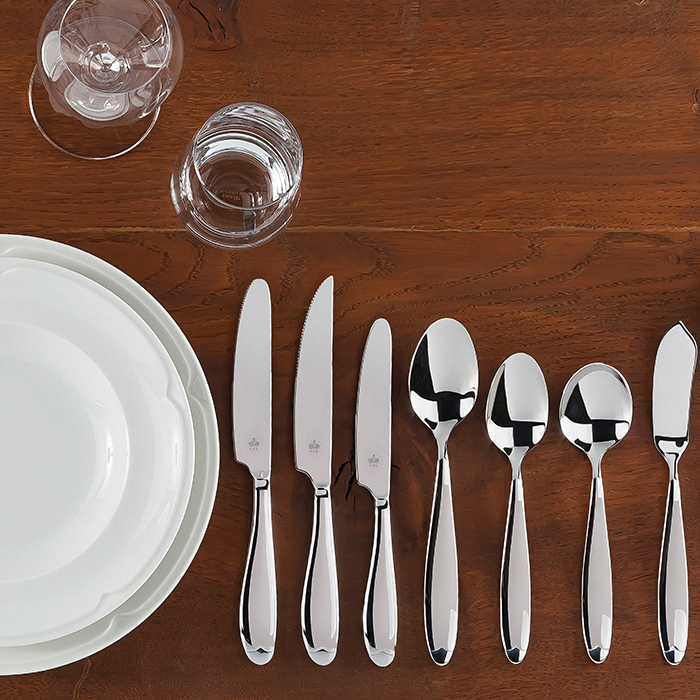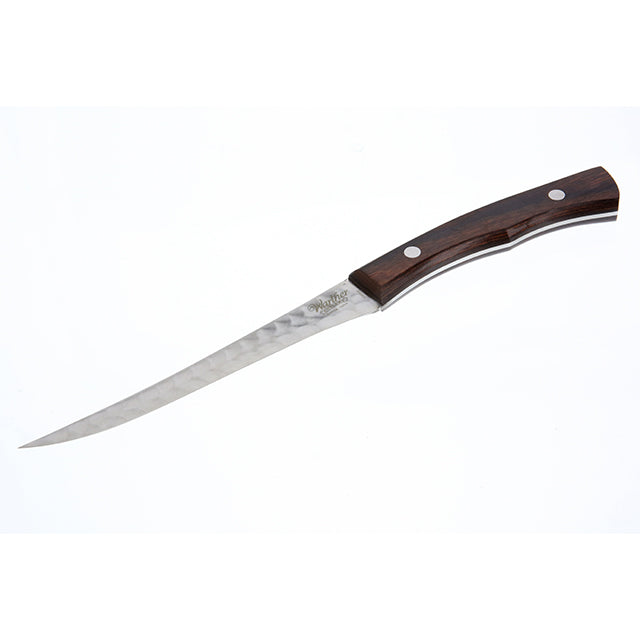The Ultimate Overview to Keeping Your Fish Knife for Longevity and Efficiency
Preserving a fish knife is crucial for ensuring its long life and optimal performance. Correct care entails a collection of steps, consisting of cleansing, sharpening, and storage. Each stage adds to the knife's efficiency throughout usage. Comprehending these methods can make a substantial difference in the life expectancy of this important device. Nonetheless, numerous individuals ignore critical aspects of maintenance that can lead to degeneration. What are these often-forgotten actions?
Selecting the Right Fish Knife for Your Needs
When selecting the ideal fish knife, what trick functions should one take into consideration? The blade's adaptability is paramount, permitting accuracy while filleting numerous fish varieties (fish knife). A slim, narrow blade commonly improves ability to move, making it much easier to browse around bones and skin. The material of the blade likewise plays a vital function; stainless-steel offers resilience and corrosion resistance, important for frequent direct exposure to water
In addition, the manage's layout should not be neglected. It ought to provide a comfy hold, ideally featuring non-slip products that ensure security during usage. The knife's length is another variable; shorter blades can offer far better control, while longer blades might be useful for larger fish. Ultimately, weight is very important; a well-balanced knife permits prolonged usage without tiredness. By thoroughly considering these attributes, one can select a fish knife that meets certain demands for efficient fish prep work.
Proper Cleaning Techniques After Each Use
Correct cleaning strategies after each use are crucial for preserving the durability and efficiency of a fish knife. Promptly after filleting fish, it is essential to wash the knife under cozy water to remove ranges, sludge, and any kind of residual fish juices. Making use of a soft sponge or towel, the user must delicately scrub the blade and handle, paying special attention to any type of holes where particles may build up. Stay clear of making use of abrasive materials that could scrape the blade's surface area. After cleaning, the knife should be completely dried out with a tidy towel to protect against moisture-related damage. Using a food-safe mineral oil occasionally can assist preserve its stability if the knife has a wood take care of. Saving the knife in a marked sheath or magnetic strip can further protect it from unintentional damages and guarantee it continues to be all set and tidy for future usage. Constant adherence to these cleaning techniques will certainly boost the knife's life-span and performance.
Developing Your Fish Knife: Techniques and devices
Developing a fish knife is a crucial procedure that boosts its efficiency and makes sure clean cuts while filleting. To achieve optimal sharpness, several devices can be used. A whetstone is taken into consideration one of the most effective approaches, enabling for specific control over the developing angle. Individuals ought to wet the rock and preserve a consistent 20-degree angle while gliding the blade throughout its surface area.
A refining rod can be made use of for routine maintenance, straightening the blade's edge without getting rid of material. For comfort, electric sharpeners use a quick remedy, though they may not give the exact same degree of skill as hands-on approaches.
No matter the chosen technique, it is vital to completed with a leather strop to brighten the edge, ensuring a knifelike finish. Routine developing not only lengthens the life of the fish knife but likewise improves the total efficiency of the filleting procedure.
Saving Your Fish Knife for Optimal Security
After developing a fish knife, focus should transform to its storage to preserve the blade's honesty and performance. Proper storage space is essential for avoiding damages, corrosion, and dulling. Preferably, a fish knife ought to be stored in a protective sheath or knife roll, which shields the blade from call with environmental elements and other utensils (fish knife). Magnetic strips can additionally work, enabling risk-free and obtainable storage while keeping the blade secure

Regular Maintenance Regimens to Adhere To
A consistent maintenance regimen is crucial for preserving the performance and appearance of a fish knife. Routine cleansing after each usage is crucial; rinsing the blade with warm water and light soap gets rid of any residue. It is suggested to dry the knife thoroughly to stop corrosion. Occasionally, a light application of food-safe mineral oil can aid protect the blade and maintain its sheen.

Saving here the fish knife in a protective situation or sheath prevents unintentional damages and keeps it prepared for usage. Following these maintenance regimens will significantly enhance the durability and performance of the fish knife.
Frequently Asked Inquiries
Can I Use My Fish Knife for Other Sorts Of Fish?
Yes, a fish knife can be utilized for other kinds of fish. The performance might vary depending on the knife's style and the particular fish being processed, impacting efficiency and accuracy throughout preparation.
What Materials Are Best for a Fish Knife Blade?
Stainless steel and high-carbon steel are thought about the finest materials for a fish knife blade. Stainless steel supplies deterioration resistance, while high-carbon steel supplies remarkable sharpness and side retention, essential for efficient fish preparation.
Just how Commonly Should I Replace My Fish Knife?
A fish knife should typically be changed every 3 to five years, depending on use and upkeep. Routine inspection for indicators of wear or damage can also aid figure out the correct time for substitute.
Are There Particular Brands Recognized for High Quality Fish Blades?
Specific brand names, like Wüsthof, Victorinox, and Rapala, are renowned for creating premium fish blades. These brands are identified for their toughness, intensity, and ergonomic designs, making them favored options amongst angling enthusiasts and experts alike.
Can Temperature Influence My Fish Knife's Efficiency?
Temperature level can dramatically impact a fish knife's performance. Extreme heat may trigger blade materials to warp, while cool problems can bring about brittleness. Keeping an optimal temperature is vital for preserving the knife's performance and longevity.
The knife's length is one more aspect; much shorter blades can offer much better control, while longer blades might be beneficial for bigger fish. Promptly after filleting fish, it is crucial to wash the knife under cozy water to get rid of ranges, slime, and any residual fish juices. After honing a fish knife, attention needs to transform to its storage to preserve the blade's honesty and efficiency. Preferably, a fish knife need to be stored in a protective sheath or knife roll, which shields the blade from contact with environmental aspects and various other utensils. Yes, a fish knife can be utilized for other kinds of fish.